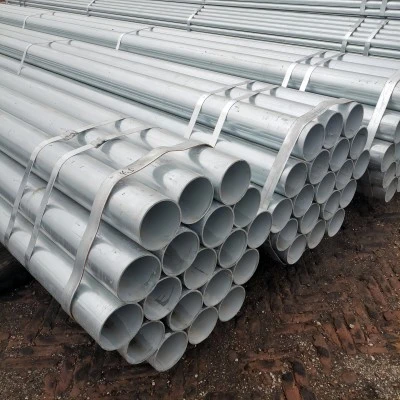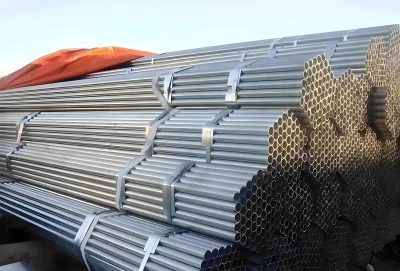When it comes to reliable and durable water line solutions, ASTM A53 galvanized steel pipe stands out as a top choice for pipeline engineers and project managers worldwide. This versatile piping material, known for its exceptional corrosion resistance and longevity, has become a staple in water supply systems, particularly in challenging environments like the Middle East, Australia, and Southeast Asia. A53 galvanized pipe offers a perfect balance of strength, durability, and cost-effectiveness, making it an ideal option for large-scale water infrastructure projects.
|
|
|
Corrosion Resistance: Key Advantage for Water Systems
A53 Galvanized Pipe: Rust-Free Water Delivery
The primary advantage of A53 galvanized pipe in water systems is its superior corrosion resistance. The galvanization process involves coating the steel pipe with a layer of zinc, creating a barrier that protects the underlying metal from rust and corrosion. This protective layer ensures that water flowing through the pipes remains free from contamination, maintaining its quality and purity.
In harsh environments, such as coastal areas or regions with aggressive soil conditions, A53 galvanized pipes prove their worth by withstanding corrosive elements that would quickly degrade other materials. This resistance to corrosion translates to fewer leaks, reduced maintenance needs, and a longer operational lifespan for water supply systems.
Zinc Coating: Prolonging Pipe Lifespan in Water Systems
The zinc coating on A53 galvanized pipes does more than just prevent rust; it actively extends the pipe's lifespan through a process called sacrificial protection. When exposed to corrosive elements, the zinc layer corrodes preferentially, sacrificing itself to protect the underlying steel. This self-healing property ensures that even if the coating is scratched or damaged, the pipe remains protected.
For water supply projects in regions like the Middle East, where high temperatures and saline conditions pose significant challenges, the zinc coating's ability to withstand these harsh conditions makes A53 galvanized pipes an excellent choice. The extended lifespan offered by this protective layer translates to significant cost savings over time, reducing the need for frequent replacements and minimizing system downtime.
Comparing A53 to Other Materials for Water Lines
When compared to alternative materials like PVC or copper, A53 galvanized steel pipes offer several distinct advantages for water line applications. Unlike PVC, galvanized steel pipes can withstand higher pressures and temperatures, making them suitable for a wider range of industrial and municipal water systems. They also offer greater resistance to physical damage, an important consideration in areas prone to earthquakes or ground movement.
While copper pipes are known for their corrosion resistance, they are significantly more expensive than galvanized steel, especially for large-scale projects. A53 galvanized pipes provide a more cost-effective solution without compromising on quality or durability. Additionally, galvanized steel pipes are less prone to pinhole leaks, a common issue with copper pipes in certain water conditions.
Installation Tips: Ensuring Longevity of A53 Pipes
Proper Joining Techniques for A53 Galvanized PipesTo maximize the performance and lifespan of A53 galvanized pipes in water systems, proper installation is crucial. The most common joining methods for these pipes include threading, welding, and mechanical coupling. Each method has its advantages, and the choice depends on factors such as pipe size, system pressure, and local regulations.
Threading is often preferred for smaller diameter pipes, offering a simple and effective connection method. However, care must be taken to avoid over-tightening, which can damage the protective zinc coating. For larger pipes or high-pressure systems, welding provides a strong, leak-proof joint. When welding galvanized pipes, it's essential to re-apply a zinc-rich paint or coating to the welded area to maintain corrosion resistance.
Avoiding Common Mistakes in A53 Pipe Installation
One common mistake in A53 galvanized pipe installation is failing to account for thermal expansion. Steel pipes expand and contract with temperature changes, and without proper allowance for this movement, pipes can become stressed, leading to leaks or joint failures. Using expansion joints or loops in long pipe runs can help mitigate this issue.
Another critical consideration is avoiding galvanic corrosion when connecting galvanized pipes to other metals. Using dielectric unions or insulating fittings when transitioning between different metals, such as copper to galvanized steel, is essential to prevent accelerated corrosion at these junctions.
Maintenance Best Practices for A53 Water Lines
While A53 galvanized pipes are known for their low maintenance requirements, regular inspections and proper care can further extend their service life. Periodic visual inspections can help identify any early signs of corrosion or damage, particularly at joints and fittings. In areas with hard water, scale buildup inside the pipes can be a concern. Implementing a water treatment system or regular flushing can help prevent this issue.
For buried pipelines, cathodic protection systems can provide an additional layer of corrosion prevention. These systems use sacrificial anodes or impressed current to protect the pipe from soil-based corrosion, particularly beneficial in areas with aggressive soil conditions.
Cost-Benefit Analysis: A53 vs. Alternative Materials
Initial Investment vs. Long-Term Savings with A53 Pipes
When evaluating the cost-effectiveness of A53 galvanized pipes for water systems, it's essential to consider both the initial investment and long-term savings. While the upfront cost of galvanized steel pipes may be higher than some alternatives like PVC, the long-term benefits often outweigh this initial expense.
The durability and longevity of A53 pipes translate to fewer replacements over the system's lifetime. This reduced need for pipe replacement not only saves on material costs but also minimizes labor expenses and system downtime. For large-scale projects, especially in remote or challenging environments, these long-term savings can be substantial.
A53 Galvanized Pipe: Performance in Various Water Qualities
The performance of A53 galvanized pipes can vary depending on water quality. In general, these pipes excel in a wide range of water conditions, from slightly acidic to slightly alkaline. However, extremely soft or aggressive waters can accelerate the corrosion of the zinc coating. In such cases, additional water treatment or the use of protective linings may be necessary to extend pipe life.
For projects in areas with known water quality issues, such as high mineral content or aggressive chemical composition, A53 galvanized pipes often prove more resilient than alternatives. Their ability to withstand harsh conditions makes them a reliable choice for diverse global markets, from the mineral-rich waters of the Middle East to the varying water qualities found across Southeast Asia.
ROI: A53 Pipes in Large-Scale Water Supply Projects
For large-scale water supply projects, the return on investment (ROI) of using A53 galvanized pipes can be significant. The combination of durability, low maintenance requirements, and extended service life contributes to a favorable long-term cost structure. In projects where system reliability is paramount, such as municipal water supplies or industrial water lines, the reduced risk of failures and leaks associated with A53 pipes translates to substantial savings in repair costs and lost productivity.
Moreover, the versatility of A53 galvanized pipes allows for their use in various parts of water supply systems, from main transmission lines to distribution networks. This flexibility can simplify inventory management and reduce overall project complexity, further enhancing the ROI for large-scale implementations.
ASTM A53 galvanized steel pipes offer a robust, cost-effective solution for water line systems across diverse global markets. Their superior corrosion resistance, durability, and versatility make them an excellent choice for pipeline engineers and project managers dealing with challenging environments and large-scale water infrastructure projects. While proper installation and maintenance are key to maximizing their benefits, the long-term cost savings and reliability of A53 galvanized pipes make them a smart investment for water supply systems worldwide.
ASTM A53 Galvanized Steel Pipes Manufacturer
For high-quality ASTM A53 galvanized steel pipes, Hebei Longma Group stands out as a leading manufacturer and supplier. With advanced production equipment imported from Germany and independently developed technologies, Longma Group ensures top-notch quality and consistency in its A53 galvanized pipes. Their professional team of over 300 employees, including 60+ technical experts, guarantees expert support throughout your project.
Longma Group's comprehensive testing facilities, including ultrasonic flaw detectors and industrial X-ray equipment, ensure that every pipe meets stringent quality standards. With a fast delivery time of just 7 days for standard thickness pipes and a complete range of certifications, including API 5L and ISO 9001, Longma Group offers both quality and reliability. Their competitive pricing, made possible by long-term relationships with raw material suppliers and efficient production processes, makes them an ideal choice for cost-effective, high-performance water line solutions. To learn more about their pipe products, contact us at info@longma-group.com.














